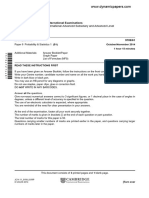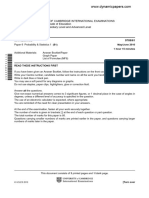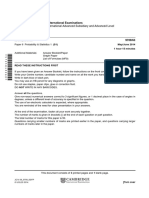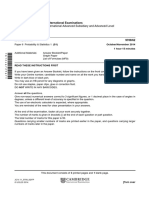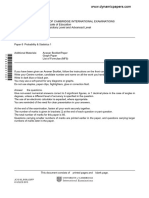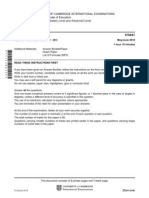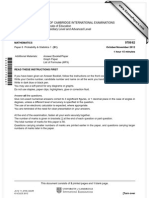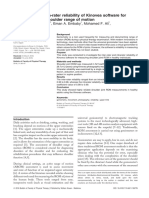University of Cambridge International Examinations General Certificate of Education Advanced Subsidiary Level and Advanced Level
University of Cambridge International Examinations General Certificate of Education Advanced Subsidiary Level and Advanced Level
Uploaded by
agnesasus123Copyright:
Available Formats
University of Cambridge International Examinations General Certificate of Education Advanced Subsidiary Level and Advanced Level
University of Cambridge International Examinations General Certificate of Education Advanced Subsidiary Level and Advanced Level
Uploaded by
agnesasus123Original Title
Copyright
Available Formats
Share this document
Did you find this document useful?
Is this content inappropriate?
Copyright:
Available Formats
University of Cambridge International Examinations General Certificate of Education Advanced Subsidiary Level and Advanced Level
University of Cambridge International Examinations General Certificate of Education Advanced Subsidiary Level and Advanced Level
Uploaded by
agnesasus123Copyright:
Available Formats
www.dynamicpapers.
com
UNIVERSITY OF CAMBRIDGE INTERNATIONAL EXAMINATIONS
General Certificate of Education
Advanced Subsidiary Level and Advanced Level
MATHEMATICS 9709/62
Paper 6 Probability & Statistics 1 (S1) May/June 2010
1 hour 15 minutes
Additional Materials: Answer Booklet/Paper
*8471957091*
Graph Paper
List of Formulae (MF9)
READ THESE INSTRUCTIONS FIRST
If you have been given an Answer Booklet, follow the instructions on the front cover of the Booklet.
Write your Centre number, candidate number and name on all the work you hand in.
Write in dark blue or black pen.
You may use a soft pencil for any diagrams or graphs.
Do not use staples, paper clips, highlighters, glue or correction fluid.
Answer all the questions.
Give non-exact numerical answers correct to 3 significant figures, or 1 decimal place in the case of angles in
degrees, unless a different level of accuracy is specified in the question.
The use of an electronic calculator is expected, where appropriate.
You are reminded of the need for clear presentation in your answers.
At the end of the examination, fasten all your work securely together.
The number of marks is given in brackets [ ] at the end of each question or part question.
The total number of marks for this paper is 50.
Questions carrying smaller numbers of marks are printed earlier in the paper, and questions carrying larger
numbers of marks later in the paper.
This document consists of 3 printed pages and 1 blank page.
© UCLES 2010 [Turn over
www.dynamicpapers.com
2
1 The times in minutes for seven students to become proficient at a new computer game were measured.
The results are shown below.
15 10 48 10 19 14 16
(i) Find the mean and standard deviation of these times. [2]
(ii) State which of the mean, median or mode you consider would be most appropriate to use as a
measure of central tendency to represent the data in this case. [1]
(iii) For each of the two measures of average you did not choose in part (ii), give a reason why you
consider it inappropriate. [2]
2 The lengths of new pencils are normally distributed with mean 11 cm and standard deviation 0.095 cm.
(i) Find the probability that a pencil chosen at random has a length greater than 10.9 cm. [2]
(ii) Find the probability that, in a random sample of 6 pencils, at least two have lengths less than
10.9 cm. [3]
3
Cumulative
frequency
1000
900
800
Country A
700
Country B
600
500
400
300
200
100
0 Weight (kg)
0 1 2 3 4 5 6
The birth weights of random samples of 900 babies born in country A and 900 babies born in country B
are illustrated in the cumulative frequency graphs. Use suitable data from these graphs to compare
the central tendency and spread of the birth weights of the two sets of babies. [6]
© UCLES 2010 9709/62/M/J/10
www.dynamicpapers.com
3
4 The random variable X is normally distributed with mean µ and standard deviation σ .
(i) Given that 5σ = 3µ , find P(X < 2µ ). [3]
(ii) With a different relationship between µ and σ , it is given that P(X < 13 µ ) = 0.8524. Express µ in
terms of σ . [3]
5 Two fair twelve-sided dice with sides marked 1, 2, 3, 4, 5, 6, 7, 8, 9, 10, 11, 12 are thrown, and the
numbers on the sides which land face down are noted. Events Q and R are defined as follows.
Q : the product of the two numbers is 24.
R : both of the numbers are greater than 8.
(i) Find P(Q). [2]
(ii) Find P(R). [2]
(iii) Are events Q and R exclusive? Justify your answer. [2]
(iv) Are events Q and R independent? Justify your answer. [2]
6 A small farm has 5 ducks and 2 geese. Four of these birds are to be chosen at random. The random
variable X represents the number of geese chosen.
(i) Draw up the probability distribution of X . [3]
8
(ii) Show that E(X ) = 7 and calculate Var(X ). [3]
(iii) When the farmer’s dog is let loose, it chases either the ducks with probability 35 or the geese with
probability 52 . If the dog chases the ducks there is a probability of 10
1
that they will attack the dog.
3
If the dog chases the geese there is a probability of 4 that they will attack the dog. Given that the
dog is not attacked, find the probability that it was chasing the geese. [4]
7 Nine cards, each of a different colour, are to be arranged in a line.
(i) How many different arrangements of the 9 cards are possible? [1]
The 9 cards include a pink card and a green card.
(ii) How many different arrangements do not have the pink card next to the green card? [3]
Consider all possible choices of 3 cards from the 9 cards with the 3 cards being arranged in a line.
(iii) How many different arrangements in total of 3 cards are possible? [2]
(iv) How many of the arrangements of 3 cards in part (iii) contain the pink card? [2]
(v) How many of the arrangements of 3 cards in part (iii) do not have the pink card next to the green
card? [2]
© UCLES 2010 9709/62/M/J/10
www.dynamicpapers.com
4
BLANK PAGE
Permission to reproduce items where third-party owned material protected by copyright is included has been sought and cleared where possible. Every reasonable
effort has been made by the publisher (UCLES) to trace copyright holders, but if any items requiring clearance have unwittingly been included, the publisher will
be pleased to make amends at the earliest possible opportunity.
University of Cambridge International Examinations is part of the Cambridge Assessment Group. Cambridge Assessment is the brand name of University of
Cambridge Local Examinations Syndicate (UCLES), which is itself a department of the University of Cambridge.
9709/62/M/J/10
You might also like
- AJC H2 Math 2013 Prelim P2Document6 pagesAJC H2 Math 2013 Prelim P2nej200695No ratings yet
- 9709 s12 QP 61 PDFDocument4 pages9709 s12 QP 61 PDFVeronica MardonesNo ratings yet
- 9709 s11 QP 62 PDFDocument4 pages9709 s11 QP 62 PDFSzeYee OonNo ratings yet
- University of Cambridge International Examinations General Certificate of Education Advanced Subsidiary Level and Advanced LevelDocument4 pagesUniversity of Cambridge International Examinations General Certificate of Education Advanced Subsidiary Level and Advanced LevelMaitaishe GoraNo ratings yet
- University of Cambridge International Examinations General Certificate of Education Advanced Subsidiary Level and Advanced LevelDocument4 pagesUniversity of Cambridge International Examinations General Certificate of Education Advanced Subsidiary Level and Advanced LevelHayati SekerNo ratings yet
- Spiral 3Document96 pagesSpiral 3Anusree SivasamyNo ratings yet
- University of Cambridge International Examinations General Certificate of Education Advanced Subsidiary Level and Advanced LevelDocument4 pagesUniversity of Cambridge International Examinations General Certificate of Education Advanced Subsidiary Level and Advanced LevelOmer SaeedNo ratings yet
- 9709 s10 QP 63Document4 pages9709 s10 QP 63Hubbak KhanNo ratings yet
- 9709 s13 QP 61-MergedDocument732 pages9709 s13 QP 61-MergedAdithyaNo ratings yet
- June 2009 QP - S1 CIE Maths A-LevelDocument4 pagesJune 2009 QP - S1 CIE Maths A-LevelSoniaNo ratings yet
- University of Cambridge International Examinations General Certificate of Education Advanced Subsidiary Level and Advanced LevelDocument4 pagesUniversity of Cambridge International Examinations General Certificate of Education Advanced Subsidiary Level and Advanced LevelVeronica MardonesNo ratings yet
- Cambridge International Advanced Subsidiary and Advanced LevelDocument4 pagesCambridge International Advanced Subsidiary and Advanced LevelHayati SekerNo ratings yet
- University of Cambridge International Examinations General Certificate of Education Advanced Subsidiary Level and Advanced LevelDocument4 pagesUniversity of Cambridge International Examinations General Certificate of Education Advanced Subsidiary Level and Advanced LevelHayati SekerNo ratings yet
- University of Cambridge International Examinations General Certificate of Education Advanced LevelDocument4 pagesUniversity of Cambridge International Examinations General Certificate of Education Advanced LevelhyyyNo ratings yet
- University of Cambridge International Examinations General Certificate of Education Advanced Subsidiary Level and Advanced LevelDocument4 pagesUniversity of Cambridge International Examinations General Certificate of Education Advanced Subsidiary Level and Advanced LevelMuhammad InamNo ratings yet
- University of Cambridge International Examinations General Certificate of Education Advanced Subsidiary Level and Advanced LevelDocument4 pagesUniversity of Cambridge International Examinations General Certificate of Education Advanced Subsidiary Level and Advanced LevelHayati SekerNo ratings yet
- 9709 s14 QP 61Document4 pages9709 s14 QP 61hhvjyuiNo ratings yet
- 9709 s14 QP 63Document4 pages9709 s14 QP 63hhvjyuiNo ratings yet
- University of Cambridge International Examinations General Certificate of Education Advanced LevelDocument4 pagesUniversity of Cambridge International Examinations General Certificate of Education Advanced LevelFrankschoolNo ratings yet
- Cambridge International Advanced Subsidiary and Advanced LevelDocument4 pagesCambridge International Advanced Subsidiary and Advanced Leveljunk filesNo ratings yet
- Cambridge International Advanced Subsidiary and Advanced LevelDocument4 pagesCambridge International Advanced Subsidiary and Advanced LevelKelvin SerimweNo ratings yet
- Cambridge International Advanced Subsidiary and Advanced LevelDocument4 pagesCambridge International Advanced Subsidiary and Advanced LevelHayati SekerNo ratings yet
- University of Cambridge International Examinations General Certificate of Education Advanced Subsidiary Level and Advanced LevelDocument4 pagesUniversity of Cambridge International Examinations General Certificate of Education Advanced Subsidiary Level and Advanced LevelZaid NaveedNo ratings yet
- Cambridge International Advanced Subsidiary and Advanced LevelDocument4 pagesCambridge International Advanced Subsidiary and Advanced LevelHayati SekerNo ratings yet
- University of Cambridge International Examinations General Certificate of Education Advanced Subsidiary Level and Advanced LevelDocument4 pagesUniversity of Cambridge International Examinations General Certificate of Education Advanced Subsidiary Level and Advanced LevelHayati SekerNo ratings yet
- Cambridge International Advanced Subsidiary and Advanced LevelDocument4 pagesCambridge International Advanced Subsidiary and Advanced LevelbababassimNo ratings yet
- University of Cambridge International Examinations General Certificate of Education Advanced LevelDocument4 pagesUniversity of Cambridge International Examinations General Certificate of Education Advanced LevelDanish Naeem KhanNo ratings yet
- University of Cambridge International Examinations General Certificate of Education Advanced Subsidiary Level and Advanced LevelDocument4 pagesUniversity of Cambridge International Examinations General Certificate of Education Advanced Subsidiary Level and Advanced Levelroukaiya_peerkhanNo ratings yet
- 9709 w15 QP 61Document4 pages9709 w15 QP 61yuke kristinaNo ratings yet
- 9709 s10 QP 63Document4 pages9709 s10 QP 63Abrar JahinNo ratings yet
- 22 - June 2003 QPDocument4 pages22 - June 2003 QPAhmed AliNo ratings yet
- Maths KunjaDocument460 pagesMaths KunjaGaneshNo ratings yet
- Cambridge International Advanced Subsidiary and Advanced LevelDocument4 pagesCambridge International Advanced Subsidiary and Advanced LevelV-academy MathsNo ratings yet
- University of Cambridge International Examinations General Certificate of Education Advanced Subsidiary Level and Advanced LevelDocument4 pagesUniversity of Cambridge International Examinations General Certificate of Education Advanced Subsidiary Level and Advanced LevelHayati SekerNo ratings yet
- 9709_s14_qp_62Document4 pages9709_s14_qp_62Hiba HassanNo ratings yet
- 6046 Q 1 SpecimenDocument8 pages6046 Q 1 SpecimenEmmanuel Chipembere100% (1)
- Cambridge International Advanced Subsidiary and Advanced LevelDocument4 pagesCambridge International Advanced Subsidiary and Advanced LevelLaura Higueras GómezNo ratings yet
- s16 QP 71watermark-230201-133402Document15 pagess16 QP 71watermark-230201-133402Navid BackupNo ratings yet
- 9709 w02 QP 6Document4 pages9709 w02 QP 6michael hengNo ratings yet
- Mathematics StatisticsDocument4 pagesMathematics StatisticsmarryNo ratings yet
- 9709 s12 QP 73Document4 pages9709 s12 QP 73Vivian SiewNo ratings yet
- Mathematics Statistics (S1)Document4 pagesMathematics Statistics (S1)Hayati SekerNo ratings yet
- University of Cambridge International Examinations General Certificate of Education Advanced Subsidiary Level and Advanced LevelDocument4 pagesUniversity of Cambridge International Examinations General Certificate of Education Advanced Subsidiary Level and Advanced LevelHayati SekerNo ratings yet
- Mathematics StatisticsDocument4 pagesMathematics StatisticsTheresa ArthurNo ratings yet
- 9709 w03 QP 7Document4 pages9709 w03 QP 7michael hengNo ratings yet
- Mathematics Statistics: PAPER 6 Probability & Statistics 1 (S1)Document4 pagesMathematics Statistics: PAPER 6 Probability & Statistics 1 (S1)Ronald McdonaldNo ratings yet
- 9709 w05 QP 6Document4 pages9709 w05 QP 6Basil El GoharyNo ratings yet
- 9709 w08 QP 6Document4 pages9709 w08 QP 6Str33tRulerNo ratings yet
- University of Cambridge International Examinations General Certificate of Education Advanced Subsidiary Level and Advanced LevelDocument4 pagesUniversity of Cambridge International Examinations General Certificate of Education Advanced Subsidiary Level and Advanced LevelV-academy MathsNo ratings yet
- Cambridge International Advanced LevelDocument4 pagesCambridge International Advanced Levelyuke kristinaNo ratings yet
- 9709 w10 QP 61Document4 pages9709 w10 QP 61Sherman TanNo ratings yet
- November 2011 (v2) QP - S1Document4 pagesNovember 2011 (v2) QP - S1bidush dahalNo ratings yet
- Mathematics StatisticsDocument4 pagesMathematics StatisticsHayati SekerNo ratings yet
- 9709 w12 QP 62Document4 pages9709 w12 QP 62Aj AgenNo ratings yet
- Pan African University: Institute For Basic Sciences, Technology and InnovationDocument9 pagesPan African University: Institute For Basic Sciences, Technology and InnovationMarc MarinNo ratings yet
- Cambridge International Advanced Subsidiary and Advanced LevelDocument4 pagesCambridge International Advanced Subsidiary and Advanced LevelIgbereyivwe TejiriNo ratings yet
- KINOVEA - Inter-Rater and Intra-Rater Reliability of Kinovea Software For Measurement of Shoulder Range of MotionDocument8 pagesKINOVEA - Inter-Rater and Intra-Rater Reliability of Kinovea Software For Measurement of Shoulder Range of MotionTiago MarcheseNo ratings yet
- Chapter 15 FinalDocument20 pagesChapter 15 FinalMichael Hu100% (1)
- Maths Matrix 2Document25 pagesMaths Matrix 2andyrobin058No ratings yet
- Toc Cia IiiDocument4 pagesToc Cia Iiikavishree 1911No ratings yet
- Some Guidelines and Guarantees For Common Random NumbersDocument25 pagesSome Guidelines and Guarantees For Common Random NumbersAditya TNo ratings yet
- (CS21003: Algorithms-I) Online-Quiz/Test: Question-3: All-Pairs Shortest Path (Marks: 7)Document12 pages(CS21003: Algorithms-I) Online-Quiz/Test: Question-3: All-Pairs Shortest Path (Marks: 7)Hima Vamsi KumarNo ratings yet
- Comparative Evaluation of Filters For Liver Ultrasound Image EnhancementDocument5 pagesComparative Evaluation of Filters For Liver Ultrasound Image EnhancementInternational Journal of Application or Innovation in Engineering & ManagementNo ratings yet
- MTH202 Assignment SolutionDocument2 pagesMTH202 Assignment Solutioncs619finalproject.com100% (1)
- Human Rights in The Age of Artificial IntelligenceDocument40 pagesHuman Rights in The Age of Artificial IntelligenceVictor Eme100% (1)
- 2002 Mathematics Paper2Document30 pages2002 Mathematics Paper2api-37009440% (1)
- Science 8 Q1 Exam ReviewerDocument16 pagesScience 8 Q1 Exam ReviewerSarah Jane CasipongNo ratings yet
- 6.1 Laws of Sines-ModifiedDocument21 pages6.1 Laws of Sines-ModifiednarabenessaNo ratings yet
- Pole-Zero-Gain Filters: Chapter InsightDocument13 pagesPole-Zero-Gain Filters: Chapter InsightAldon JimenezNo ratings yet
- Elastic Analysis of Load Distribution in Wide Faced Spur GearsDocument208 pagesElastic Analysis of Load Distribution in Wide Faced Spur GearsJulian Steward100% (1)
- Mixing in Bubble Column and Airlift ReactorsDocument8 pagesMixing in Bubble Column and Airlift ReactorsOki SetiawanNo ratings yet
- Icon DLL Speed and VelocityDocument3 pagesIcon DLL Speed and VelocityCarla Christine Coralde100% (3)
- Chapter 3Document154 pagesChapter 3Lucas WeeNo ratings yet
- Specific Process Conditions For Non-Hazardous ClasDocument5 pagesSpecific Process Conditions For Non-Hazardous Clasdavid limNo ratings yet
- L6 - Presentation On Theoratical Details of Qual2K ModelDocument44 pagesL6 - Presentation On Theoratical Details of Qual2K ModelMacklera MrutuNo ratings yet
- Assignment 1Document14 pagesAssignment 1Maslinah FadillahNo ratings yet
- Functions BDocument4 pagesFunctions Brahmetomukemil35No ratings yet
- Ccoom Mpplleexx Ppoorrttffoolliioo Ooppttiim Miizzaattiioonn Wwiitthh PpoorrttffoolliiooaannaallyyttiiccssDocument51 pagesCcoom Mpplleexx Ppoorrttffoolliioo Ooppttiim Miizzaattiioonn Wwiitthh PpoorrttffoolliiooaannaallyyttiiccssDanna JordanNo ratings yet
- Torsion Chapter 6Document43 pagesTorsion Chapter 6venkeeku100% (1)
- OR NoteDocument72 pagesOR NoteAbrham JemalNo ratings yet
- PPS Faizal Kadiwal Ab1Document43 pagesPPS Faizal Kadiwal Ab1ALPESHKUMAR PATEL100% (1)
- Lesson Plan Part of SpreadsheetDocument3 pagesLesson Plan Part of SpreadsheetRia Lopez100% (5)
- Dissertação ALGA PDFDocument11 pagesDissertação ALGA PDFNuno Telmo LopesNo ratings yet
- CompileDocument17 pagesCompileJUAN CARLOS PAYI LOPEZNo ratings yet
- Pythons AssignmentDocument17 pagesPythons AssignmentMuskan ChandelNo ratings yet
- 3 Sinusoids and PhasorsDocument19 pages3 Sinusoids and PhasorsManh Hoang VanNo ratings yet












